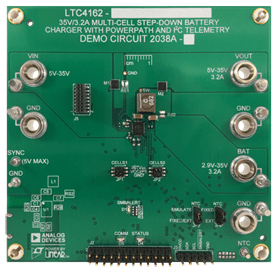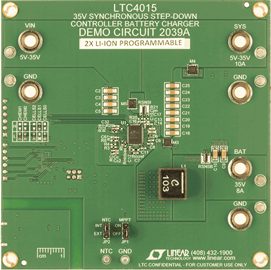
Simplify design of medium-to-high power battery circuits
It is common for many battery-powered devices to require a wide variety of charging sources, battery chemistries, voltages, and currents. For example, industrial, medical, and automotive battery charger circuits demand higher voltages and currents as newer large-battery packs are emerging for all types of battery chemistries.
Current integrated circuit (IC)-based solutions cover just a fraction of the many possible combinations of input voltage, charge voltage, and charge current. A cumbersome combination of ICs and discrete components has routinely been used to cover most of the remaining, more difficult combinations and topologies. Now some simpler, more compact, monolithic solutions are available to solve these problems.
Analog Devices’ full-featured battery charging and PowerPath™ manager ICs, the LTC4162 and LTC4015, simplify a very difficult high voltage and high current charging system. These devices efficiently manage power distribution between input sources, such as wall adapters, backplanes, solar panels, etc., and the charging of various battery chemistries, including Li-Ion/polymer, LiFePO4, and SLA. Their simple solution and compact footprints enable them to achieve high performance in leading-edge applications where only more complicated, older technology switching regulator-based topologies such as SEPIC were once the only option.
The LTC4162 Battery Charger
The LTC4162-L is an advanced monolithic synchronous step-down switching battery charger and PowerPath™ manager that seamlessly manages power distribution between input sources such as wall adapters, backplanes, solar panels, etc., and a rechargeable Lithium-Ion/Polymer battery.
Features
- Li-Ion/Polymer Battery Charger with Termination
- Wide Charging Input Voltage Range: 4.5V to 35V
- High-Efficiency Synchronous Operation
- 16-Bit Digital Telemetry System Monitors VBAT, IBAT, RBAT, TBAT, TDIE, VIN, IIN, VOUT
- Charges 1-8 Lithium-Ion/Polymer Cells
- Input Undervoltage Charge Current Limit Loop
- Input MPPT for Solar Panel Inputs
- Input Current Limit Prioritizes System Load Output
- Low Loss PowerPath™
- Instant-On Operation with Discharged or Missing Battery
- JEITA Temperature Controlled Charging
- Pin Compatible with LiFePO4 and SLA Versions
Evaluation Kit: DC2038A
Demonstration circuit 2038A shows the LTC4162 multicell step-down battery charger with PowerPath™ and I2C telemetry operating with a configurable chemistry and cell count. The LTC4162 supports up to eight cells for Li-Ion, nine cells for LiFePO4, and 6V, 12V, 18V, or 24V lead-acid batteries. Programmable and fully autonomous charge algorithms can be chosen for each of the chemistries.

The LTC4015 Battery Charger
The LTC4015 is a highly integrated, high voltage, multichemistry, synchronous step-down battery charger with onboard telemetry functions. However, it features a controller architecture with offboard power FETs for higher charge current capability (up to 20 A or more depending on external components chosen).
Features
- Multichemistry Li-Ion/Polymer, LiFePO4, or Lead-Acid Battery Charger with Termination
- High Efficiency Synchronous Buck Battery Charger
- Digital Telemetry System Monitors VBAT, IBAT, RBAT, NTC Ratio (Battery Temperature), VIN, IIN, VSYSTEM, Die Temperature
- Coulomb Counter and Integrated 14-Bit ADC
- Wide Charging Input Voltage Range: 4.5V to 35V
- Wide Battery Voltage Range: Up to 35V
- Input Undervoltage Charge Current Limit Loop
- Maximum Power Point Tracking
- Optional I2C Serial Port Control
- Input Current Limit Prioritizes System Load Output
- Input and Output Ideal Diodes Provide Low Loss PowerPath™ Operation
- Instant-On Operation with Discharged Battery
Evaluation Kit: DC2039A
Demonstration Circuit 2039A features the LTC4015EUHF, a Multichemistry Buck Battery Charger with Digital Telemetry System, operating as a 2-cell Li-Ion, 8A battery charger. The DC2039A allows configuring the LTC4015 to support up to 9 cells for Li-Ion and LiFePO4, and 3, 6, or 12 cells for Lead-Acid batteries. Programmable and fully automatic charge algorithms can be chosen for each of the chemistries.

Contact Us


